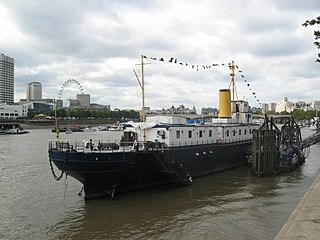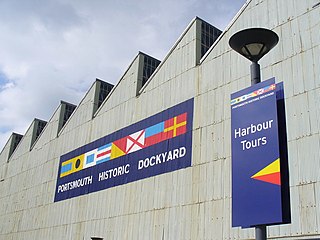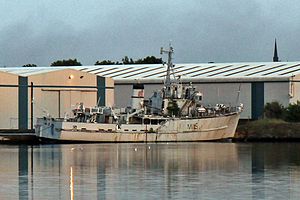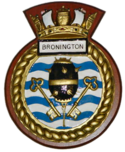
HMS Warrior is a 40-gun steam-powered armoured frigate built for the Royal Navy in 1859–1861. She was the name ship of the Warrior-class ironclads. Warrior and her sister ship HMS Black Prince were the first armour-plated, iron-hulled warships, and were built in response to France's launching in 1859 of the first ocean-going ironclad warship, the wooden-hulled Gloire. Warrior conducted a publicity tour of Great Britain in 1863 and spent her active career with the Channel Squadron. Obsolescent following the 1873 commissioning of the mastless and more capable HMS Devastation, she was placed in reserve in 1875, and was "paid off" – decommissioned – in 1883.

HMS Plymouth was a Royal Navy Rothesay-class frigate. In 1982, Plymouth was one of the first Royal Navy ships to arrive in the South Atlantic during the Falklands War.

Vittoria Dock is a dock in Birkenhead, Wirral Peninsula, England. It was built between 1904 and 1908, from land reclaimed during the construction of the Great Float.

HMS Cavalier is a retired C-class destroyer of the Royal Navy. She was laid down by J. Samuel White and Company at East Cowes on 28 March 1943, launched on 7 April 1944, and commissioned on 22 November 1944. She served in World War II and in various commissions in the Far East until she was decommissioned in 1972. After decommissioning she was preserved as a museum ship and currently resides at Chatham Historic Dockyard.

Royal Navy Dockyards were state-owned harbour facilities where ships of the Royal Navy were built, based, repaired and refitted. Until the mid-19th century the Royal Dockyards were the largest industrial complexes in Britain.

The Commander-in-Chief Fleet (CINCFLEET) was the admiral responsible for the operations of the ships, submarines and aircraft of the British Royal Navy from 1971 until April 2012. The post was subordinate to the First Sea Lord, the professional head of the Naval Service. In its last years, as the Navy shrank, more administrative responsibilities were added.

His Majesty's Naval Base, Portsmouth is one of three operating bases in the United Kingdom for the Royal Navy. Portsmouth Naval Base is part of the city of Portsmouth; it is located on the eastern shore of Portsmouth Harbour, north of the Solent and the Isle of Wight. For centuries it was officially known as HM Dockyard, Portsmouth: as a Royal Dockyard, Portsmouth functioned primarily as a state-owned facility for building, repairing and maintaining warships; for a time it was the largest industrial site in the world.

The Ton class were coastal minesweepers built in the 1950s for the Royal Navy, but also used by other navies such as the South African Navy and the Royal Australian Navy. They were intended to meet the threat of seabed mines laid in shallow coastal waters, rivers, ports and harbours, a task for which the existing ocean-going minesweepers of the Algerine-class were not suited.

The Warship Preservation Trust was based in Birkenhead, Wirral, England and hosted Europe's largest collection of preserved warships.

HMS President is a retired Flower-class Q-ship that was launched in 1918. She was renamed HMS President in 1922 and moored permanently on the Thames as a Royal Navy Reserve drill ship. In 1982 she was sold to private owners and, having changed hands twice, served as a venue for conferences and functions as well as the offices for a number of media companies. She has been moved to Chatham on the Medway in Kent since 2016, but is due to return to the capital. She had the suffix "(1918)" added to her name in order to distinguish her from HMS President, the Royal Naval Reserve base in St Katharine Docks. She is one of the last three surviving Royal Navy warships of the First World War. She is also the sole representative of the first type of purpose built anti-submarine vessels, and is the ancestor of World War II convoy escort sloops, which evolved into modern anti-submarine frigates.

The Flower class comprised five sub-classes of sloops built under the Emergency War Programme for the Royal Navy during World War I, all of which were named after various flowers. They were popularly known as the "herbaceous borders", in humorous reference to a well-known adage about the Royal Navy, as well as to a type of garden border popular in the United Kingdom.

HMS Explorer is an Archer-class P2000-type patrol and training vessel of the British Royal Navy. The ship is primarily assigned to the Yorkshire Universities Royal Naval Unit (URNU), serving the universities of Hull, Sheffield and Leeds. The ship is based in Kingston-Upon-Hull and mainly operates on the East coast of the UK, particularly in and around the Humber estuary.

His Majesty's Naval Base, Devonport is one of three operating bases in the United Kingdom for the Royal Navy and is the sole nuclear repair and refuelling facility for the Royal Navy. The largest naval base in Western Europe, HMNB Devonport is located in Devonport, in the west of the city of Plymouth, England.

HMS Fittleton, originally named HMS Curzon, was a wooden-hulled Ton-class minesweeper of the Royal Navy which spent most of her career in the Royal Naval Reserve. She was sunk in a collision with HMS Mermaid on 20 September 1976 whilst en route to Hamburg for an official visit. Twelve naval service personnel lost their lives, making this the worst peacetime accident involving the Royal Naval Reserve.

HMS Wolverine was a Jason-class three-masted wooden screw corvette, of the Royal Navy. Later she became flagship of the Australia Station, eventually being presented to the Colony of New South Wales as a training ship for the New South Wales Naval Brigade and New South Wales Naval Artillery Volunteers.

HM LCT 7074 is the last surviving Landing Craft, Tank (LCT) in the UK. LCT 7074 is an amphibious assault ship for landing tanks, other vehicles and troops on beachheads. Built in 1944 by Hawthorn Leslie and Company, Hebburn, the Mark 3 LCT 7074 was part of the 17th LCT Flotilla during Operation Neptune in June 1944.

Portsmouth Historic Dockyard is an area of HM Naval Base Portsmouth which is open to the public; it contains several historic buildings and ships. It is managed by the National Museum of the Royal Navy as an umbrella organization representing five charities: the Portsmouth Naval Base Property Trust, the National Museum of the Royal Navy, Portsmouth, the Mary Rose Trust, the Warrior Preservation Trust Ltd and the HMS Victory Preservation Company. Portsmouth Historic Dockyard Ltd was created to promote and manage the tourism element of the Royal Navy Dockyard, with the relevant trusts maintaining and interpreting their own attractions. It also promotes other nearby navy-related tourist attractions.
In 1989 the Royal Navy was under the direction of the Navy Department in the UK Ministry of Defence. It had two main commands, CINCFLEET and Naval Home Command.


















